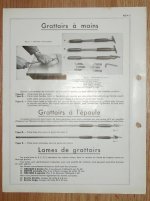Here you go:
YouTube
And...
YouTube
Pull scraping is a bit slower at first but more effective as you gain practice.
There is a persistent notion that pull scrapers are sharpened flat on the cutting edge. Not true. You can sharpen them any way you want. The depth of the scraping depends on the end radius of the scraper. Because the radius is poised at a 70 degree angle to the surface instead of 25 degrees, the pull scraper end radius has to be a bit more than double the radius of the push scraper for the same effect.
The objective properties (point count, depth, bearing quality) of pull scraping should not significantly differ from push scraping where the end radii are comparable in effect. However, body ergonomics and plain physics will result in unavoidable esthetic differences.
I prefer pull scraping in areas where fine control is necessary like working edges of oil and fastener holes, oil grooves, inside corners, etc. The scraping edge can be extended to the side beyond the shank of the scraper and 0.030 high (no more than a hook) to reach inside dovetails etc. Note how in the first video the scraper hand was picking off points on the narrow ends of an angle plate. Narrow surfaces can be tricky with push scraping where every stroke is essentially a lunge; pull scraping lends finer control thanks to body ergonomics and better visibility of the cutting edge.
Not all scraping takes place flat on a bench where the light is good and the scraper hand can stand comfortably. Some tasks are in cramped spaces, laborious, and hard to reach like under the ledge of floor mill runways, high on columns, or the tunnel dovetail of a surface grinder saddle. In these places pull scraping can work very well.
Reqardless, pull scraping should be practiced to gain skill. It's an effective alternative to push scraping that has niche advantages.
All that said, the third method (the Biax scraper) is far more productive once basic skill is developed. I can well believe Richard King's Puerto Rico student left his pull scrapers in his tool box to gather dust along with his push scrapers. However, don't toss them. Keep them handy and in good shape. The Biax can't do everything.
















